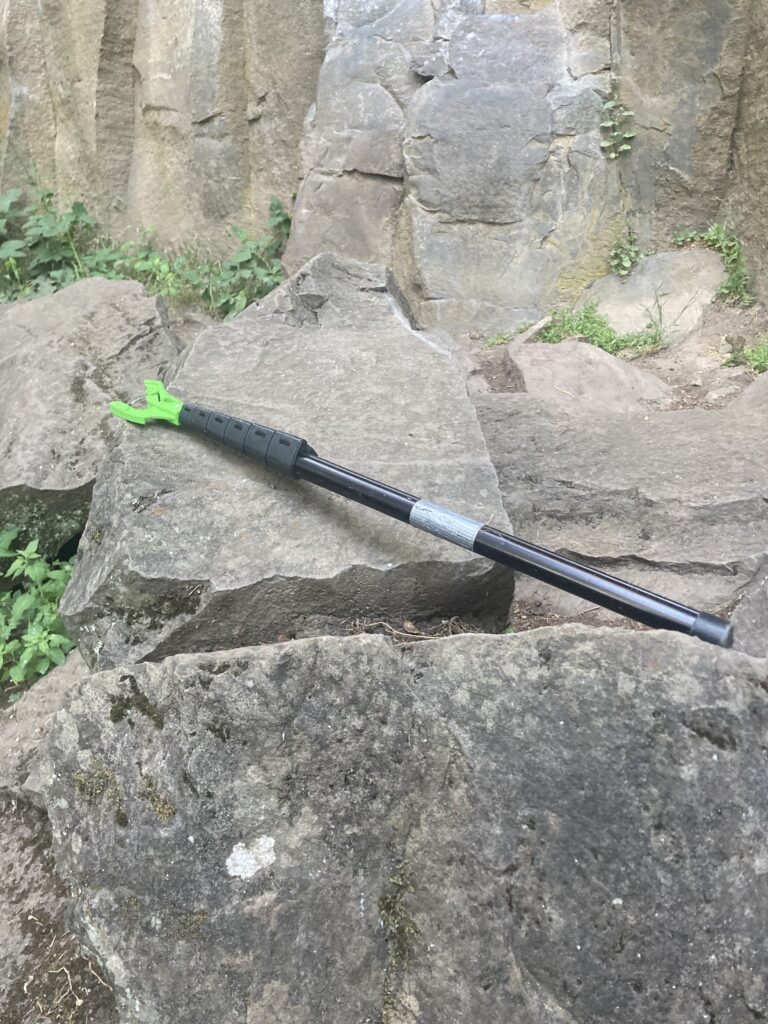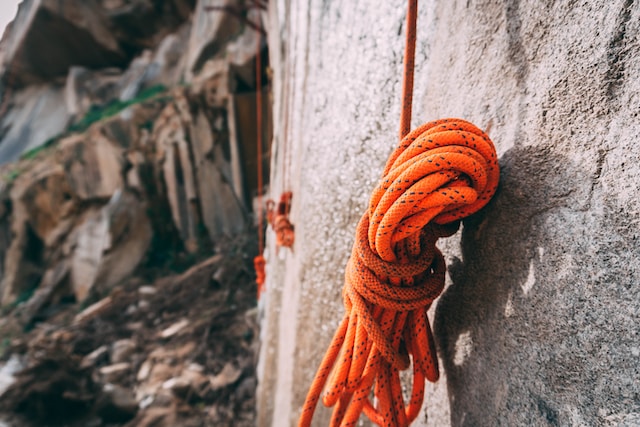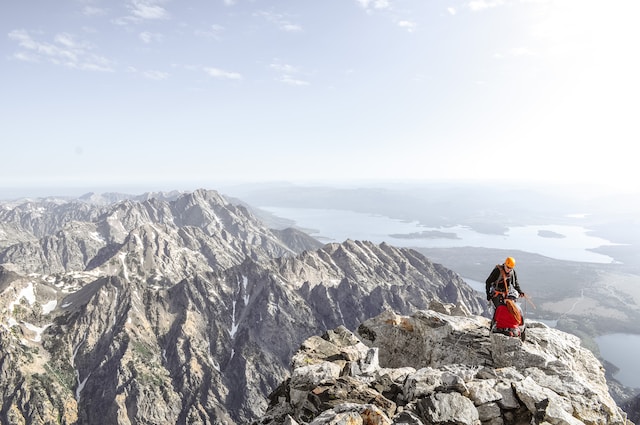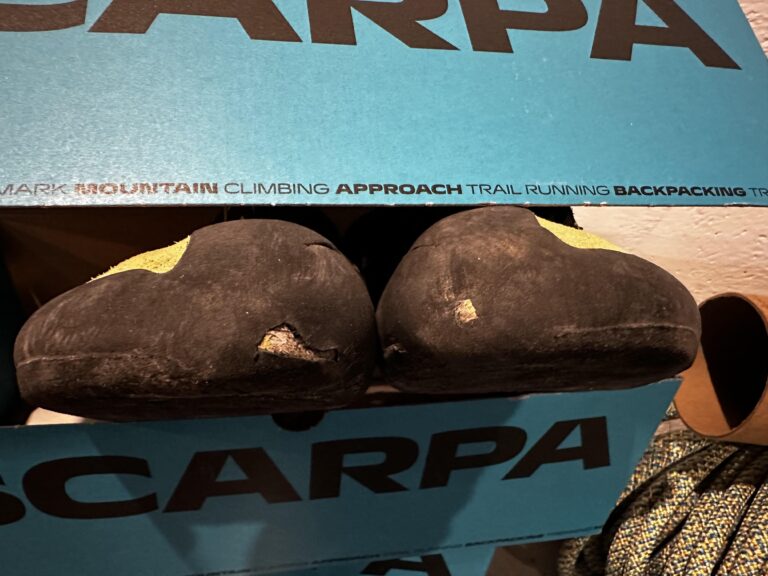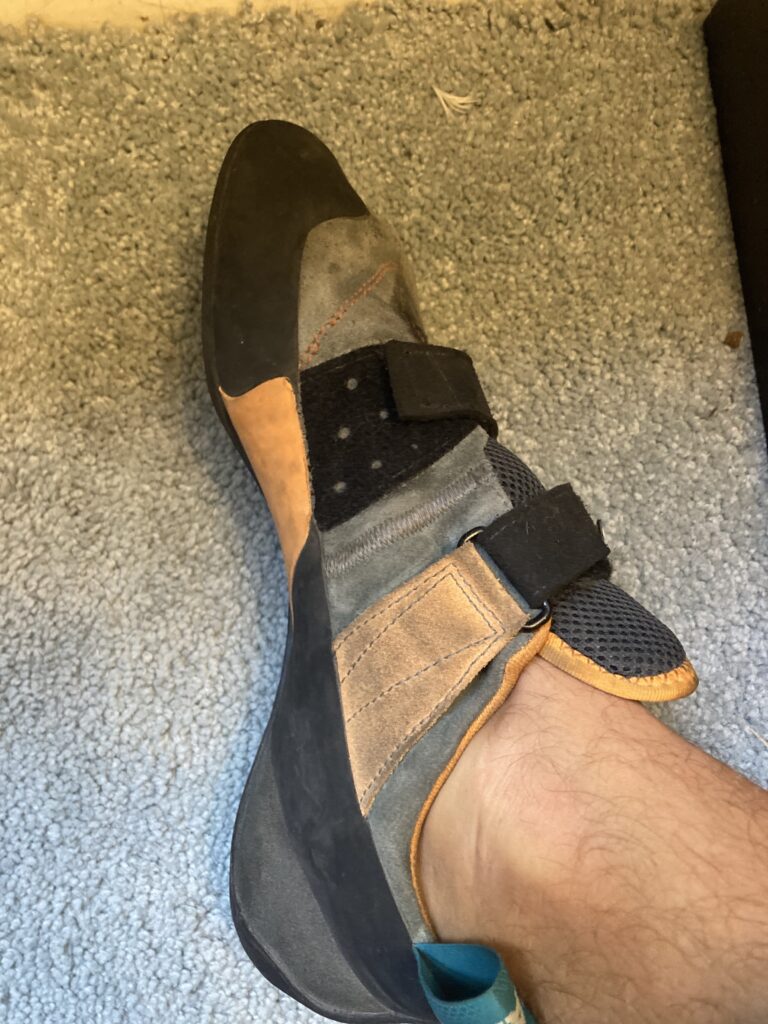Rock Climbing Gear List 2024: What You Need to Start Climbing
Last Updated on: 13th May 2024, 10:34 pm
Making sure you have the the right items on your rock climbing gear list can be a bit intimidating. Between understanding what everything is and what is necessary you actually need, there’s a lot to take in. And since climbing gear tends to be expensive, it’s an investment you want to get right.
I definitely understand. When I first got into climbing, I didn’t have a lot of disposable income, but I loved the sport. I wanted to have all the tools I needed, but only had enough cash to get the absolute essentials. The problem is a lot of information and guides out there trys to sell you on buying everything all at once instead of explaining what each item is, and when you will need it.
We do things different at The Undercling. Our goal is to help you understand the purpose of each piece of rock climbing gear on the list, and when you should get it. So whether you want to start bouldering in gyms or take on sport climbing, our list has you covered. Let’s dive in.
Rock climbing gear list overview
There’s no one list fits all for climbing gear, because not everybody climbs the same way. For instance, an outdoor boulderer is going to need a completely different set of gear than an indoor sport climber. This rock climbing gear list is meant to be comprehensive in listing all the gear people might need, but that doesn’t mean you’ll actually need , all of it.
- Shoes
- Chalk bag
- Harness
- Belay Device
- Rope
- Quickdraws
- Helmet
- Personal Anchor System (PAS)
- Climbing bag
- Anchor system
- Locking Carabiners
- Trad Rack
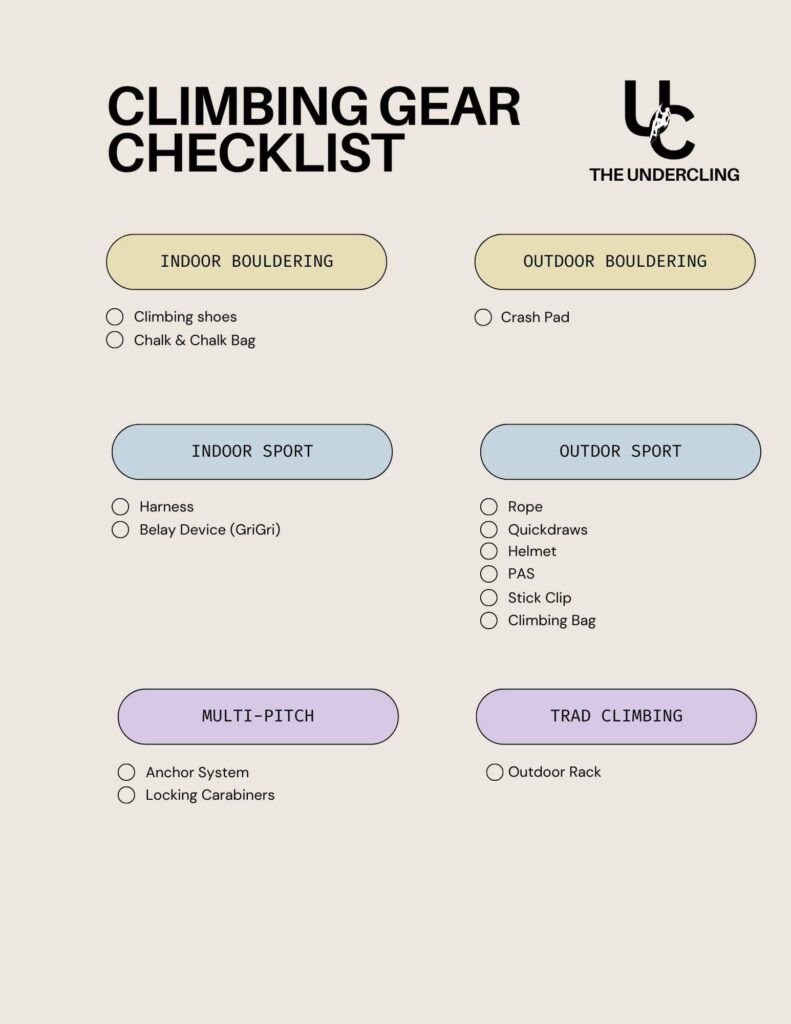
We’ll cover all these items and help you determine whether or not you actually need them.
Rock climbing gear list for beginners
My first time climbing was through a groupon for a 30 minute lesson and a day pass, rentals included. I sucked at it, but I had a lot of fun and picked up a pair of shoes the next day. Entering into climbing this way is more and more common as bouldering provides the lowest barrier to entry and still is a lot of fun. Because of that, every rock climbing gear list starts with the same two things: climbing shoes and chalk.
Climbing shoes
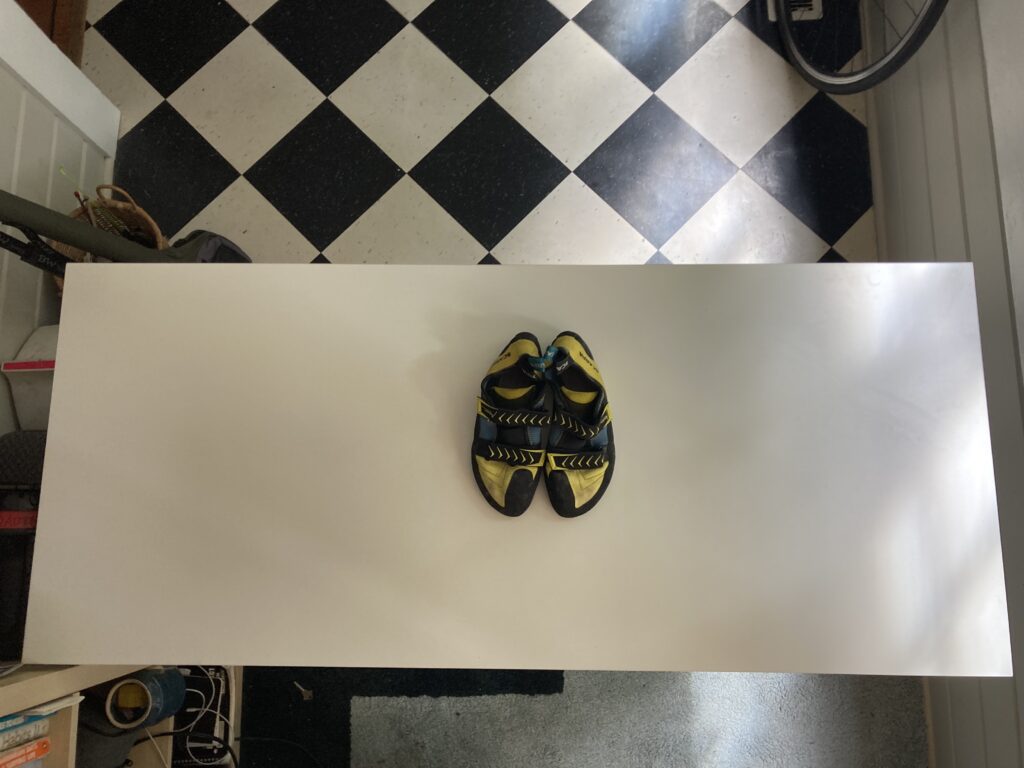
Shoes are one of most important pieces of gear you will buy, and picking out a pair is not like shopping for normal shoes. For starters, sizing is in European so you’ll have to figure out how to convert your US size. If you need help you can use our shoe size calculator. Climbing shoes are also a lot tighter, made with stiff rubber, and come in different fits ranging from neutral to aggressive. We have a whole breakdown on shoes, but if you’re just starting out, I’d recommend a neutral fit. These shoes fit beginners feet the best and usually come in the cheapest price.
Chalk & Chalk Bag
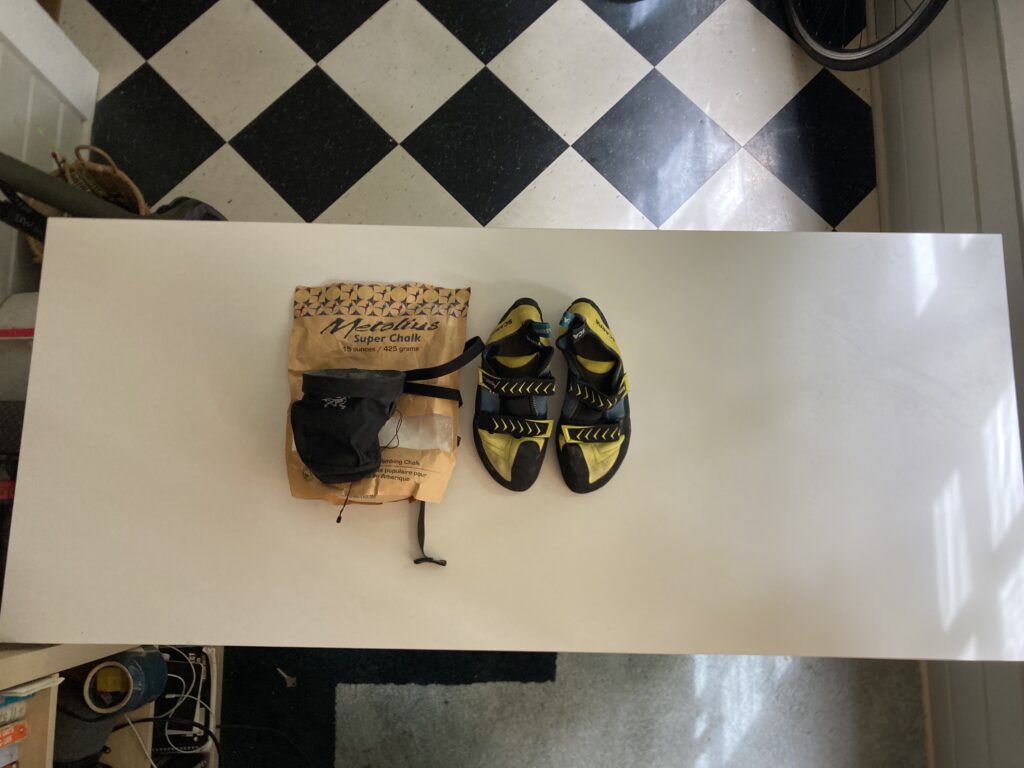
As far as chalk and chalk bags go, believe me when I say it doesn’t really matter. Some chalk bags might be lighter than others, some chalk has a different consistency, but don’t lose your head over it. Get a used chalk bag, buy a new one, use an old sock — it doesn’t matter. As long as you have a way to get the sweat off your hands (that is the point of chalk by the way) then you’re good.
If you’re a beginner but want to try sport climbing (that’s climbing with a rope) your list of essentials is a little longer. Hop down to the next section and we will cover what those are.
Rock climbing gear checklist for sport climbing
Once you start sport climbing, the list of gear gets a little longer. There is a lot of gear in this category, and you don’t need all of it to get started. Like any activity, there are essentials, nice-to-haves, and things you probably don’t need. We are here to help you understand the difference. So let’s kick off the list with the most essential pieces.
Harness
Every sport climber needs a harness. Doesn’t matter if you’re on top-rope or lead. In a gym or outdoors. First-time climber or long time veteran. A harness is a non-negotiable and both the climber and the belayer need to have one on, so sharing isn’t an option. The nice thing is harnesses don’t have to be crazy expensive, entry level models come in at $40. As you climb more, investing in a lighter weight or more advanced harness might be necessary, but there is no need for beginners to fret about that.
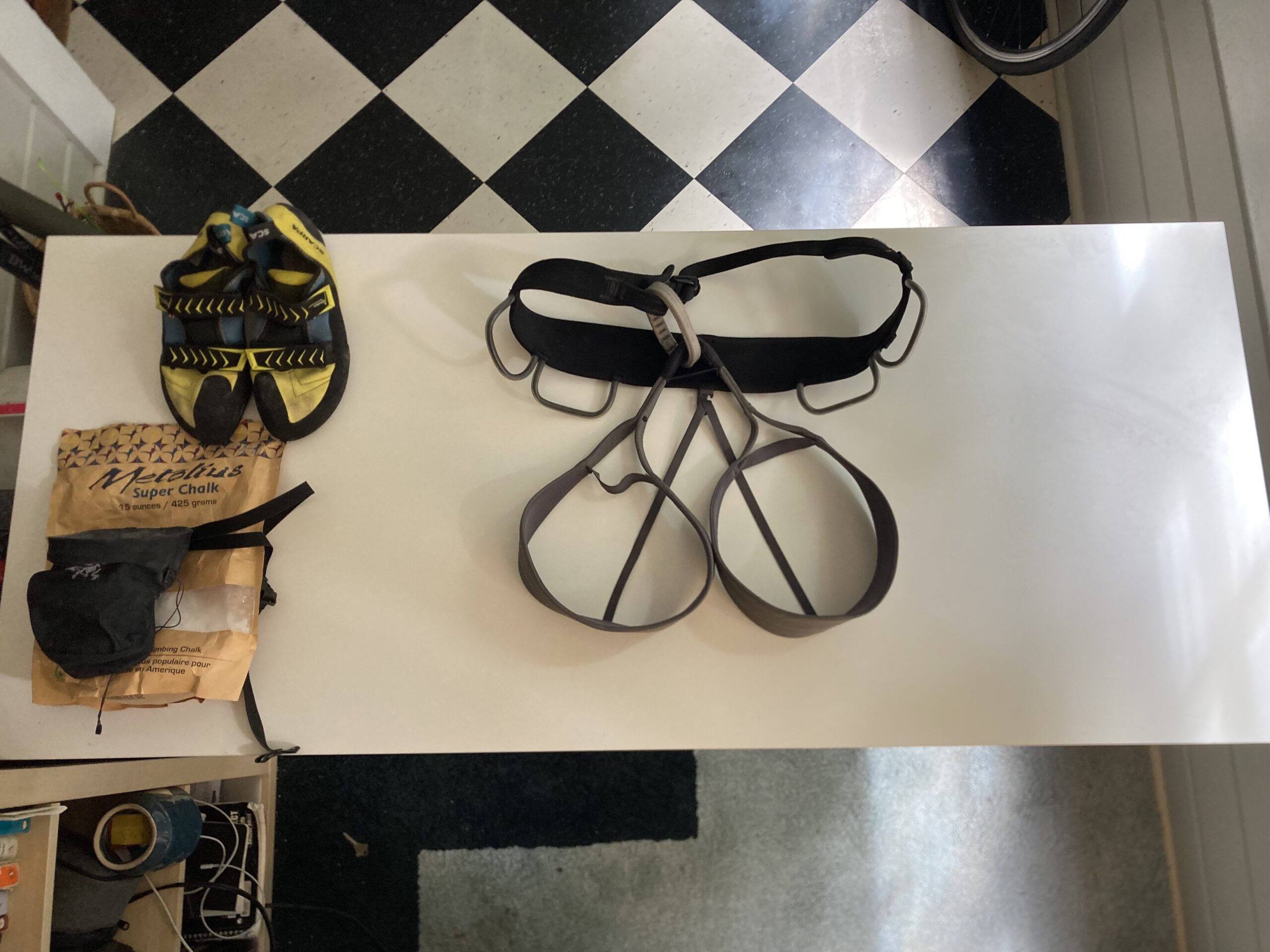
Helmets
Again another non-negotiable. Every climber at the crag needs a helmet to protect yourself. This can be the difference between life and death, even if you are just sitting at the bottom watching other folks climb. This should be bolded on your rock climbing gear checklist — don’t climb without it.
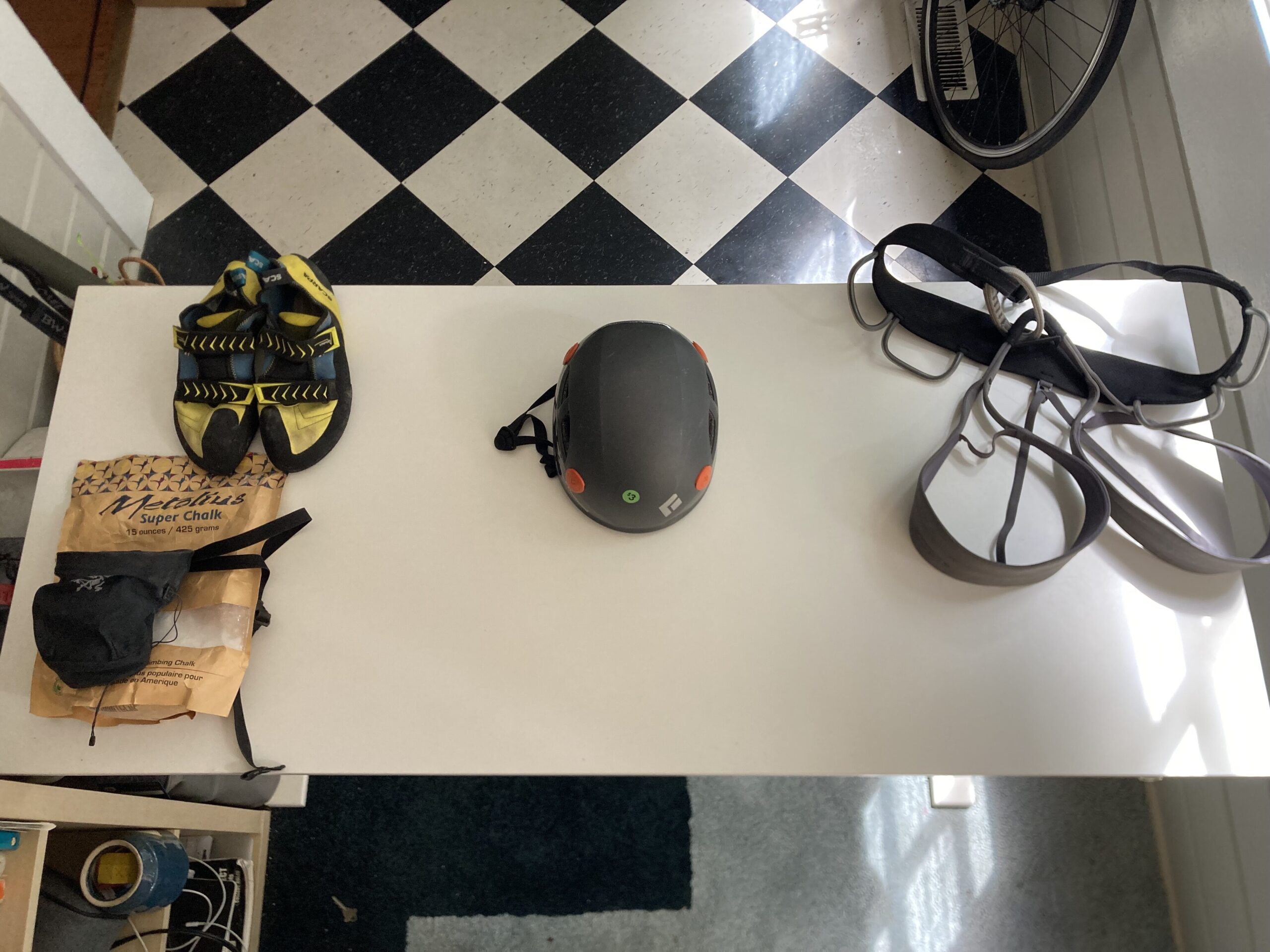
Belay Device
This is also an essential part of the sport climbing arsenal. A belay device is what belayers use to catch the rope and protect other climbers from hitting the ground if they fall. The two types of devices out there are ATC’s and the GriGri. I HIGHLY recommend the GriGri! The GriGri is designed to essentially autolock the rope when a climber falls making it much safer than an ATC the relies on the belayer to create the tension needed to start the fall with their break hand. While both work, the GriGri provides more protection from beginner mistakes than an ATC.
I’ll note here that if you are only top roping in a gym, you might not need one. Many gyms provide GriGri’s on all top rope routes, meaning you can save yourself the $100+ bucks if this is the only place you want to climb. That said when you head outdoors, you’ll need to have one yourself.
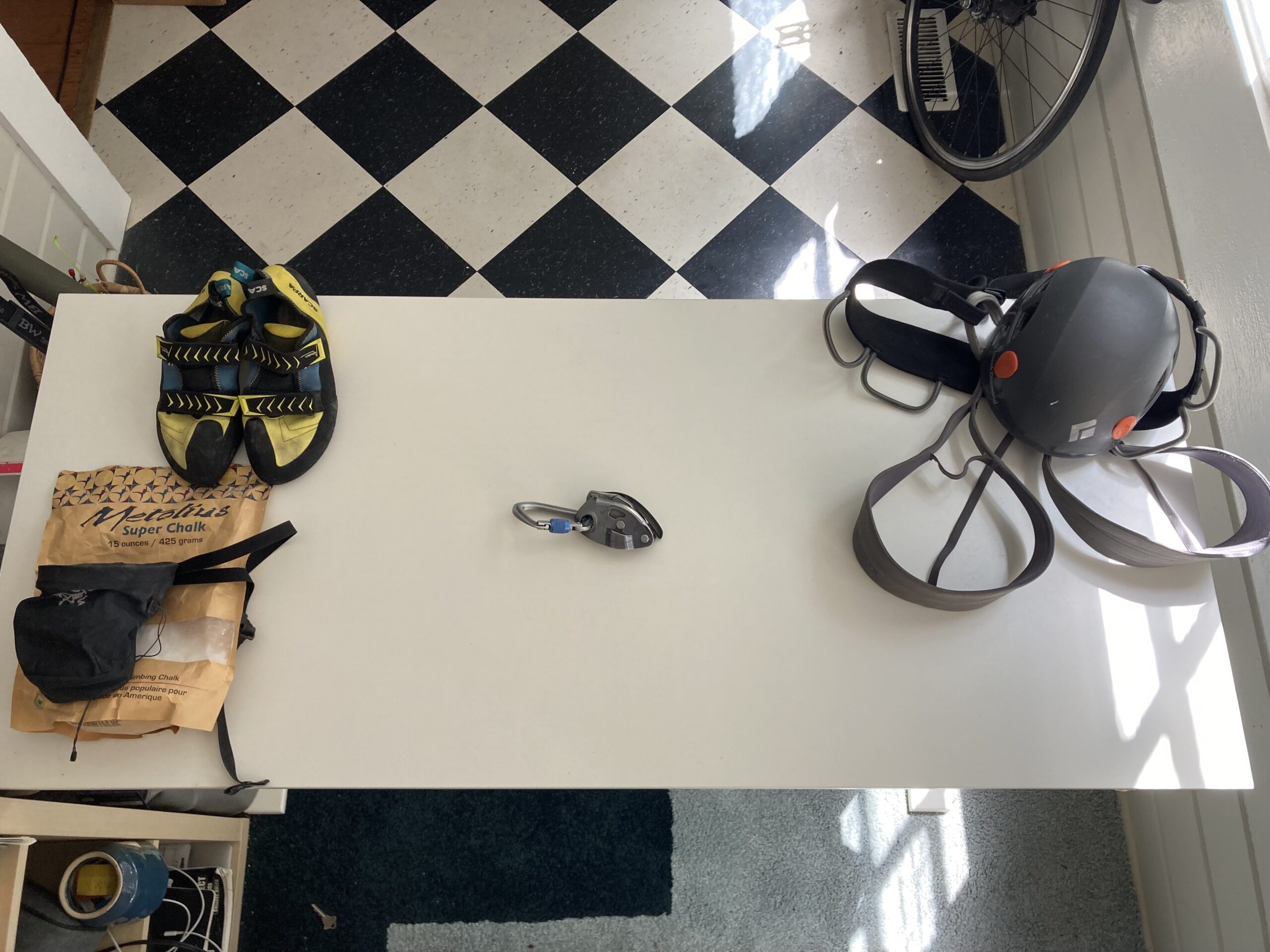
Climbing Rope
The climbing rope is another piece of climbing gear that is a non-negotiable. It’s quite literally your lifeline if you take a fall. With that said, you often don’t need your own if you are climbing in a gym. All top rope routes will have a rope already up, and many gyms will provide ropes for folks that want to lead. If you only are planning on gym climbing, there may be no need to invest in your own.
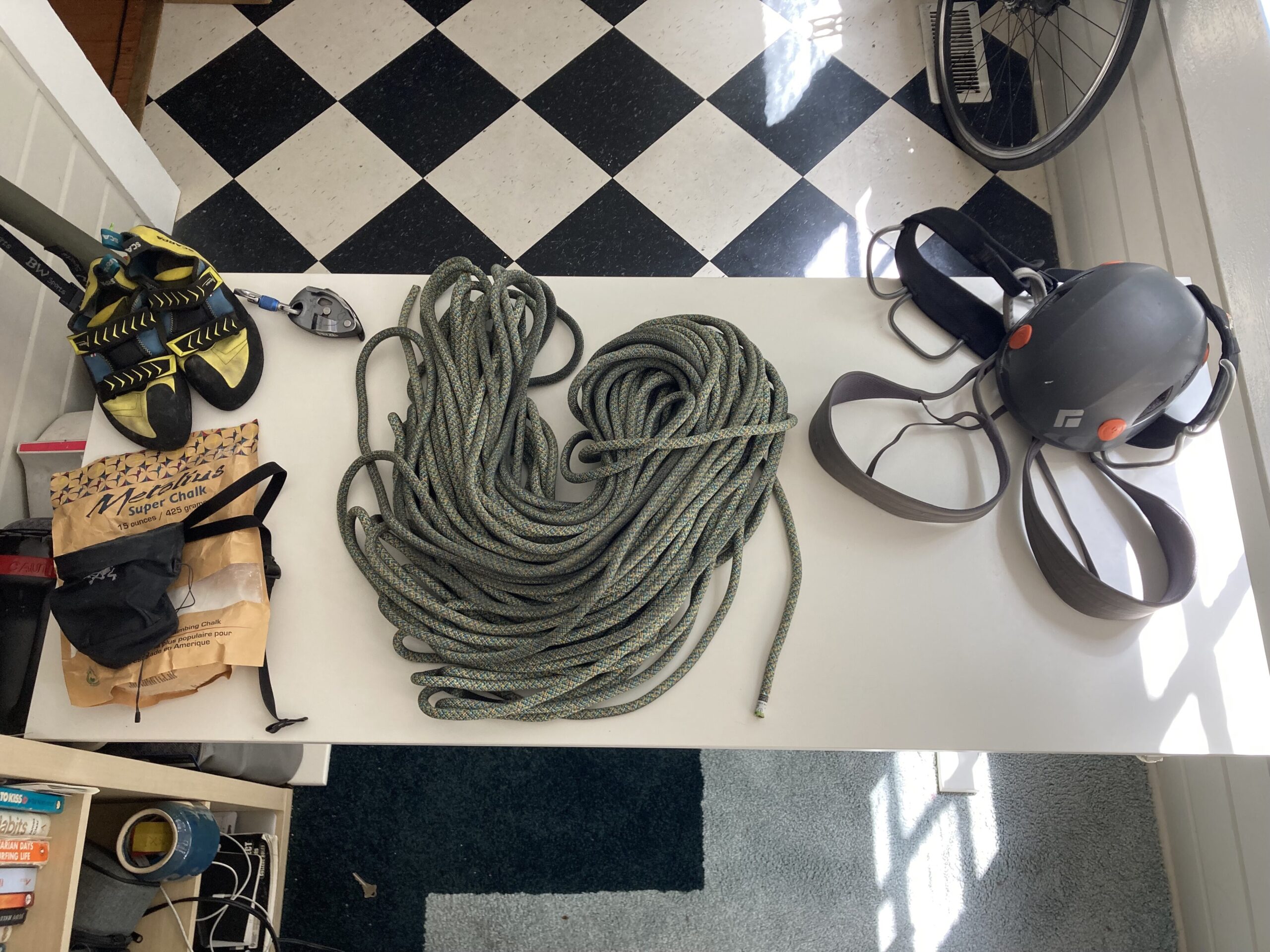
That will all change once you head outside. For outdoor climbing, you’ll need to bring your own rope and make sure it’s the right style and length for the crag you’re at. Keep in mind you only need one rope per two people, so if you are learning to climb from veterans, you probably can get away with borrowing theirs until you are ready to get your own.
Quickdraws
Quickdraws are basically two carabiners connected by a sturdy piece of fabric called a dogbone. One side attaches to the bolt on the wall, and the other is what climbers clip a rope into. Again, these are essential. But like a rope, you really only need one set per climbing duo. They are usually sold in sets of 6, but you’ll want at least 12 (though many routes require more).
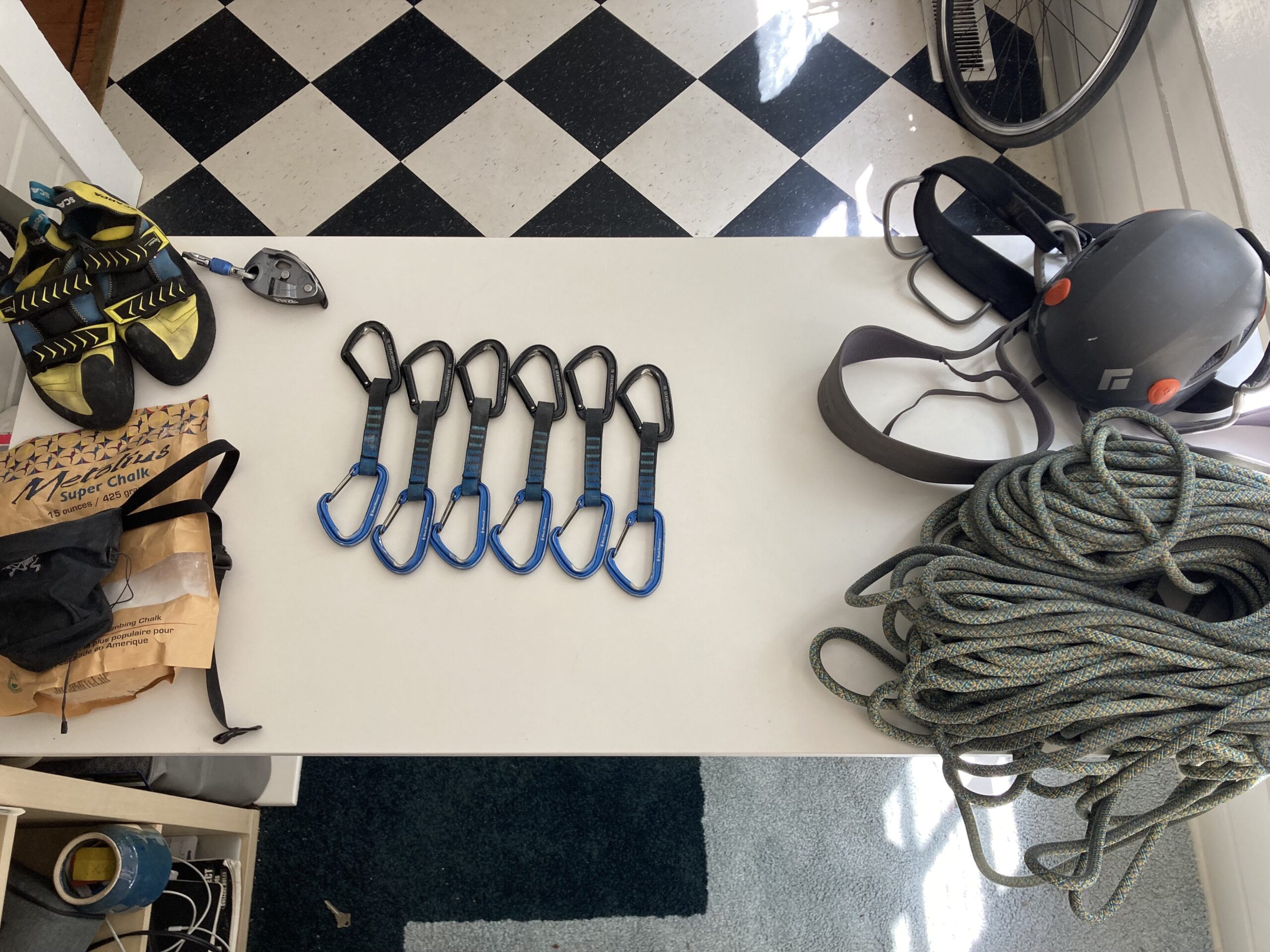
PAS (Personal anchor system)
This is another piece of gear that you only need if you are climbing outdoors. A personal anchor system (or PAS) is a device that let’s you attach yourself to the wall to take your weight off the climbing rope and belay device (also known as going indirect).
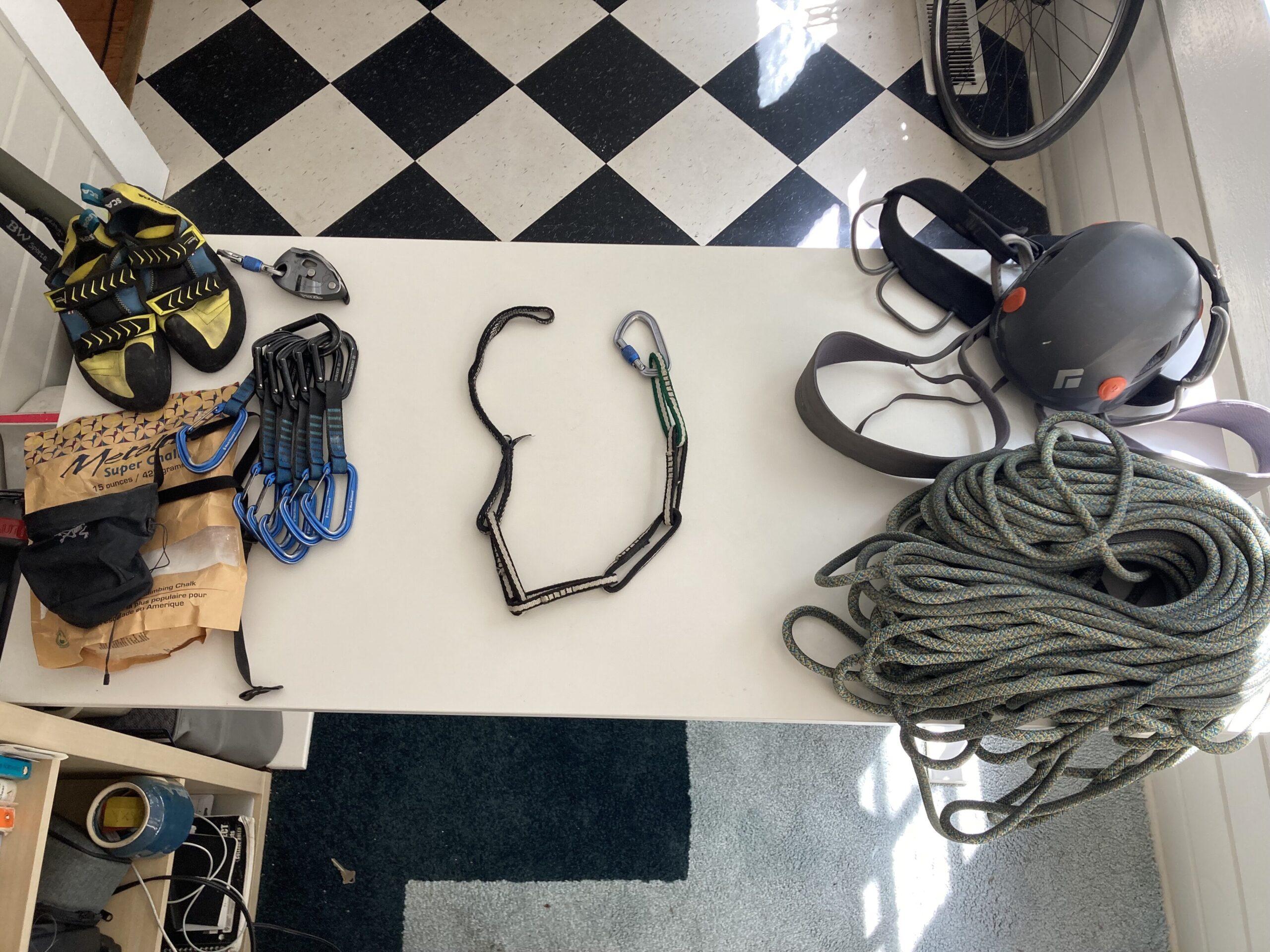
If you’re learning to climb with experienced climbers, you don’t have to have one though it is a good idea. Usually someone in your group needs one in order to clean routes (remove your gear from the wall). Regardless they are a good safety measure, but something you may be able to wait one.
Stick Clip
Stick clips make climbing a whole lot safer, but aren’t what I would call required. Stick clips are devices that extend upward so climbers can fasten a draw to the wall with the rope already through it. This let’s climbers start a route essentially top rope, so if they fall on an early move, they are protected from hitting the ground. Check out our stick clip bible for more info on best models and how to use them.
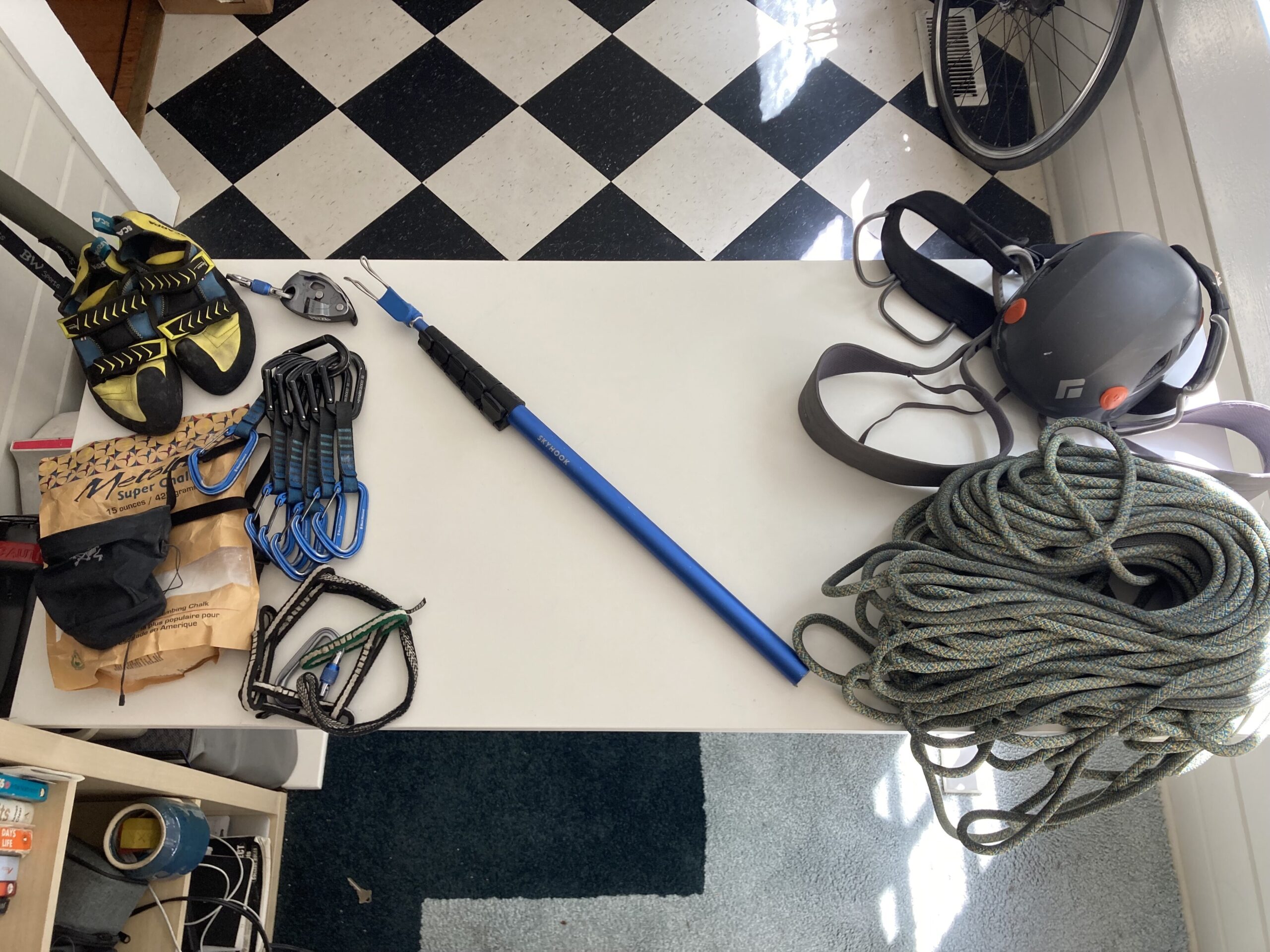
I know lots of climbers that have never used one and instead and been fine. I also know climbers that have slipped before he first bolt and sprained an ankle. If you’re climbing on easy routes, routes you’ve done before, or places with easy early moves, you’ll probably be ok without one. However they are really useful tools for making climbing safer.
Rock climbing bags: When to buy one
If you’re planning on getting into outdoor sport climbing and have bought everything on the list, you’re probably naturally thinking you’ll need a bag to carry it all. And that’s true, you do. But that doesn’t mean you have to go out and buy one.
For my whole first year of climbing I just used my backpacking backpack to carry my gear. If you have a bag large enough to fit your gear, you can totally just use that.
At some point, you probably will want a dedicated bag for climbing, if your nothing else to just store your gear. We’re working on a guide to help you choose the right one, keep an eye out for that!
Rock climbing gear checklist for multi-pitching
Multi-pitching adds in another layer of gear for climbers, though you should have the majority of what you need by this point. There are just a few specialized pieces you need in order to set out on multi-pitch climbs. Keep in mind this is more basic multi-pitches you can do in a day, not overnighters.
Locking carabiners
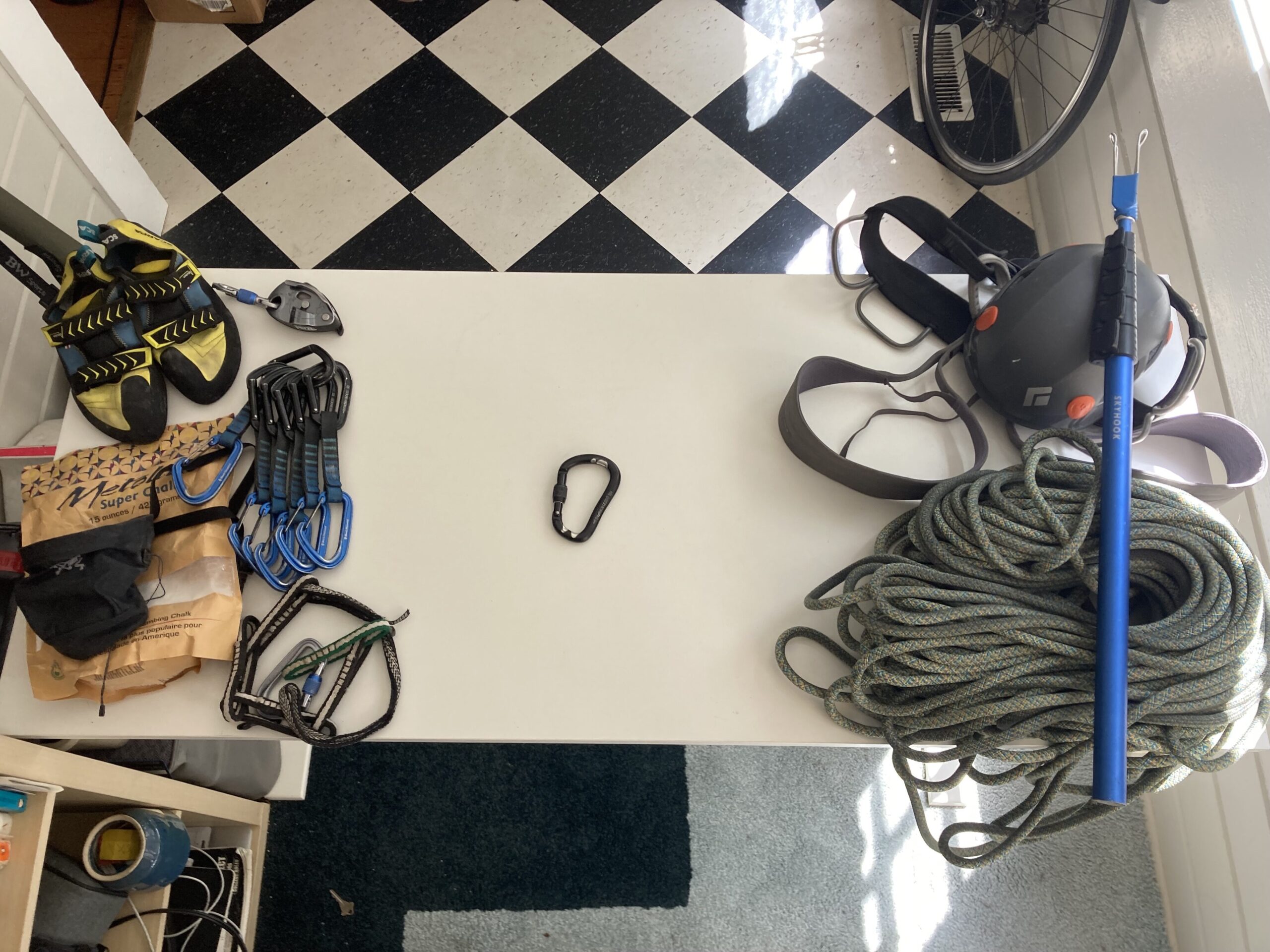
At this point you should already have one locking carabiner for your belay device and one for your PAS, but for multi-pitching, you need more. A locking carabiner simply has a mechanism to keep the gate from opening unintentionally. You will need a minimum of four: one for your belay device, one for your PAS, and two more for the rest of the set-up. That said it’s always a good idea to have a backup in case you drop one.
This post doesn’t go into all the ins and outs of multi-pitching, so make sure to do you homework before you head out.
Anchor system
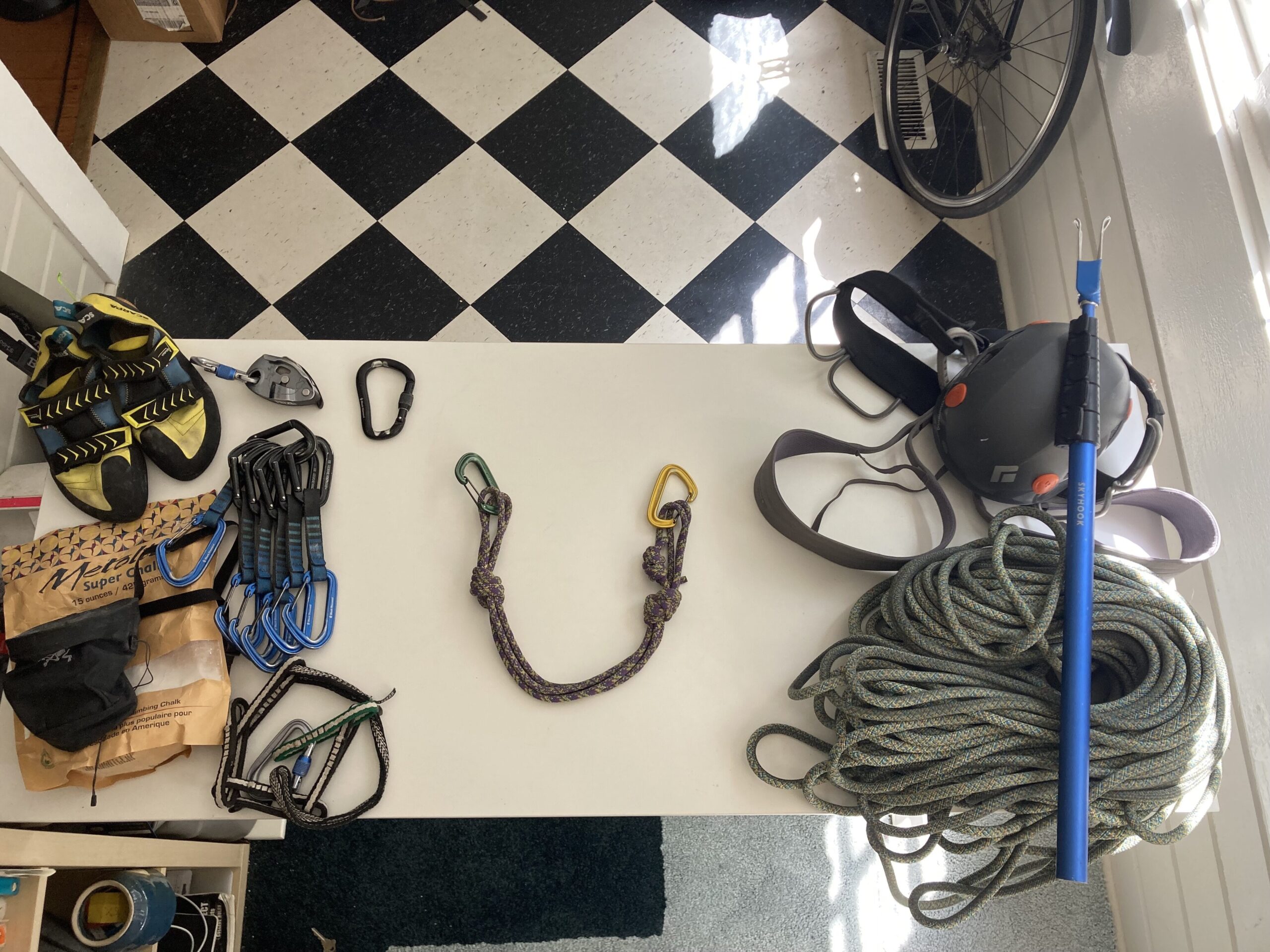
Multi-pitching requires setting up a more complex anchor in order to safely belay the second climber up. I use a quad-anchor that I made with the help of some friends, but you can buy the different parts online to make one yourself. Again this post doesn’t go into it in depth, but know it’s a non-negotiable part of the checklist.
Rock climbing gear checklist for trad climbing
Trad climbing differs from sport climbing in terms of protection. While in sport climbing you fasten quickdraws to pre-placed bolts, in trad climbing you place gear into cracks in the wall to protect your falls.
Since you encounter all types of crack systems and rock features outdoors, there are a wide range of gear that trad climbers will you for protection. A collection of trad gear is known as a trad rack, and a well equipped on is a must for any trad climber out there. We’ll cover the main ones here, but if you’re looking to try trad outdoors it’s a good idea to look at a guide book before hand and make sure you have the proper gear.
Cams
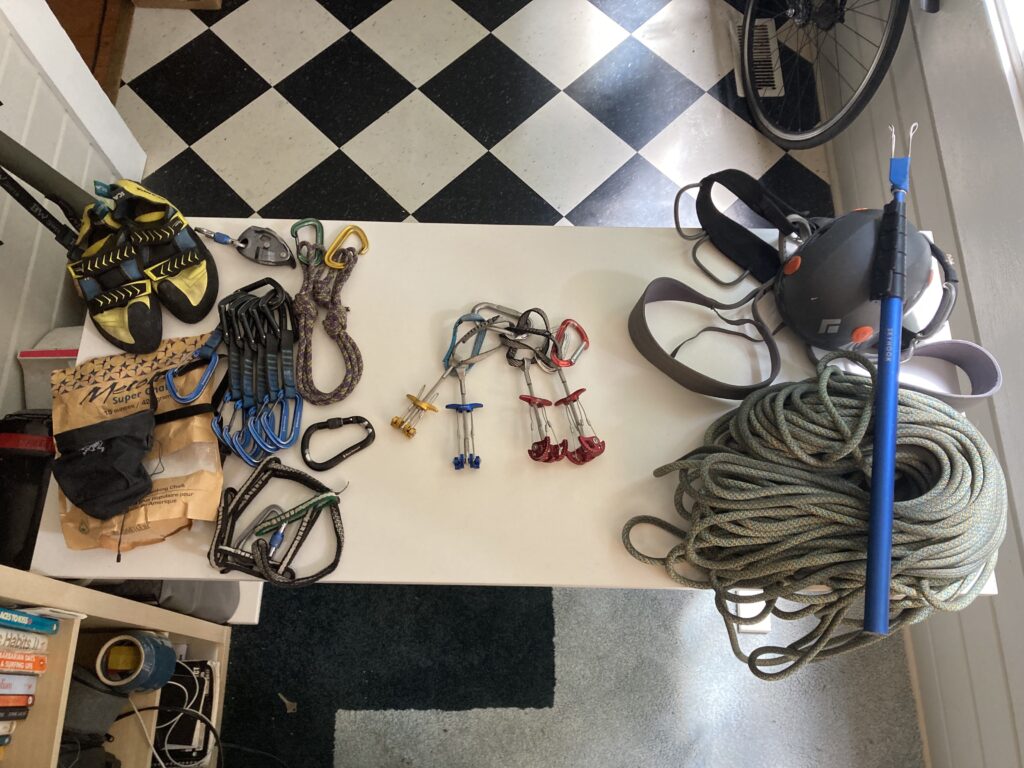
Cams, also known as camming devices, are pieces of equipment used specifically in trad climbing. They are a type of protection used to secure a climber’s rope to the rock or other surfaces.
Cams consist of a set of spring-loaded lobes attached to a stem or axle. The lobes are designed to expand and grip the rock when outward force is applied to them. This expansion creates friction and holds the cam in place within a crack or other suitable feature on the climbing surface.
The stem or axle of a climbing cam is attached to a trigger mechanism that allows the climber to retract the lobes, making it easier to place or remove the cam from a crack. When the trigger is released, the lobes expand and the cam locks into position, creating a secure anchor point for the climber’s rope. In simple terms, cams lock into place in cracks so climbers are protected from falls.
Climbing cams come in various sizes, often color-coded for easy identification. Trad climbers need a a wide range of cams in order to climb routes safely.
Nuts
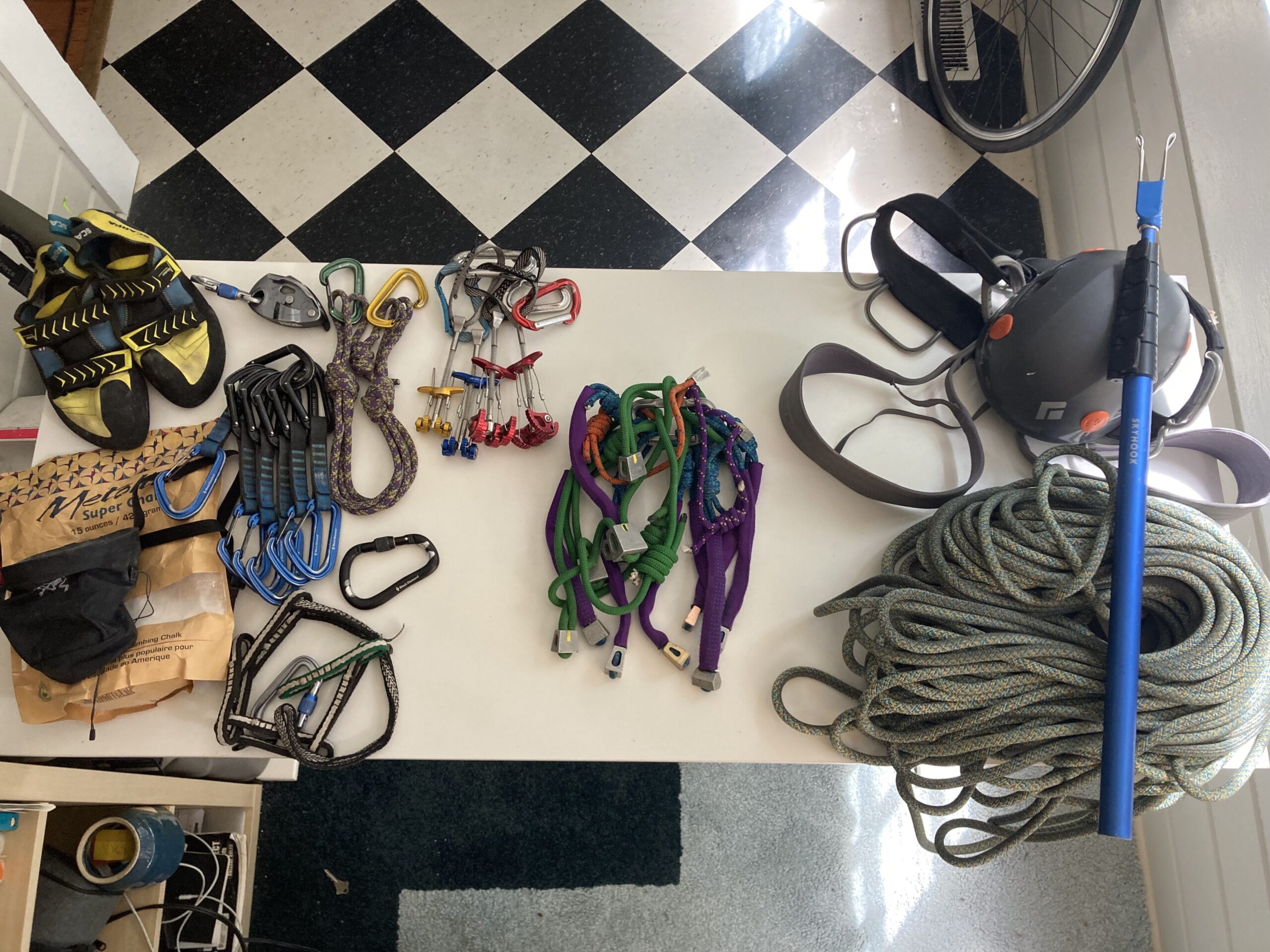
A climbing nut, also known as a nut or chock, is a type of passive protection used in rock climbing and other types of climbing activities. They are small pieces of gear designed to be wedged into cracks and crevices in the rock as protection.
Nuts are typically made of aluminum or other lightweight metals and are shaped like a tapered wedge or hexagonal prism. They have a wire attached to one end, which allows the climber to place and remove them easily.
Nuts are especially effective in small, irregular cracks where other types of protection may not fit as well.
Other trad gear
If you’re going to get serious about trad, you’re going to need more than cams and nuts. Hexes, chocks, tri-cams, and micro nuts are all other forms of protection you’ll want to consider when setting out.
Apparel on the rock climbing gear list
So far we’ve covered the gear you need to actually climb rock in the gym or outside. Shoes, rope, protection — all this stuff is essential, but it’s not all that rock climbing gear companies make.
Like any sport, clothing and apparel makes up a huge part of the gear you see in stores and online. I want to stress here that this stuff isn’t a must have! If you’re on a tight budget, don’t sweat buying new pants or tops. Any athletic clothing you have will work fine for starters. Down the line you can invest in some of the more specialized gear listed below if you’d like.
Or you can be like me and rock homemade jorts and flip flops to every crag you hit.
Approach shoes
Outdoor crags tend to be located off the beaten path. There is often scrambling across rock fields, or crawling down cliff sides to get to the base of the wall. For that reason, having a pair of shoes you trust to get yourself there safely is key.
Most folks wear running shoes, hiking boots, or something casual if it happens to be an easy walk in. But most of the big name in climbing shoes also make approach shoes to get you to the crag safe and ready to climb.
Climbing clothing
From pants to zip off shorts, long sleeve shirts to puffy jackets, there is an endless range of clothes designed for climbers. The idea behind them is providing something lightweight, the regulates temperature while keeping your whole body covered and protected from the sun.
Again, no need to break the bank investing in this stuff too early on. Any workout clothing you currently own will do fine — just be prepared for it to get a little dirty.
Can you buy used climbing gear?
Most sports have large markets of second hand gear where folks can get good discounts and save a little money as they build their collection. Climbing doesn’t work that way.
For climbers, gear is literally life or death. One faulty piece of equipment is all it takes to cause catastrophic failure. For that reason, climbing shops don’t sell used gear like protection, ropes, harnesses, or belay devices. You can buy stuff off craigslist or other peer to peer marketplaces, but use extreme caution. You should only do so if you know how to assess the quality and safety of gear.
When checking boxes on your rock climbing gear list, it’s best to get brand new stuff, especially just starting out. It’ll give you more confidence on the rock. That said, for shoes and apparel (the non life dependent stuff) there are marketplaces like Gear Trade where you can shop.
Wrap Up: Rock climbing gear list
Got all your boxes checked? You’re ready to hit the gym or the crag! At least gear wise. Remember that having all the items on the rock climbing gear list is only half the battle. It’s worthless unless you know how to use everything on it. Make sure to properly learn how everything functions before setting out to use it. Get out there, have fun, and happy climbing from The Undercling!

